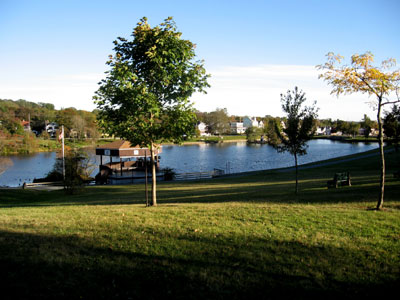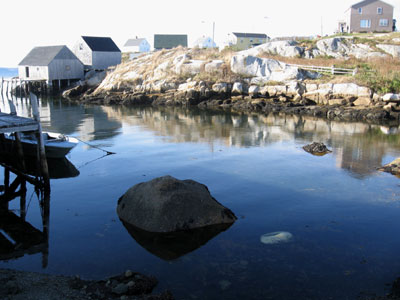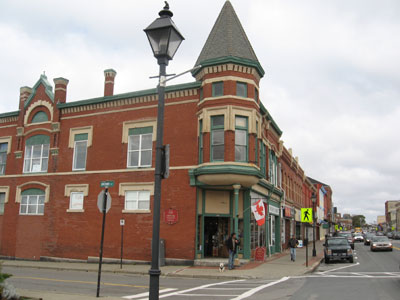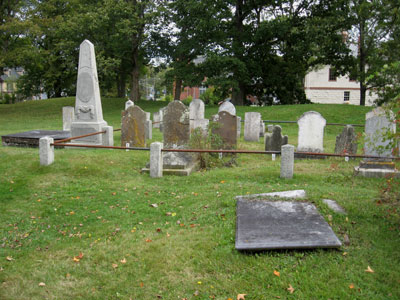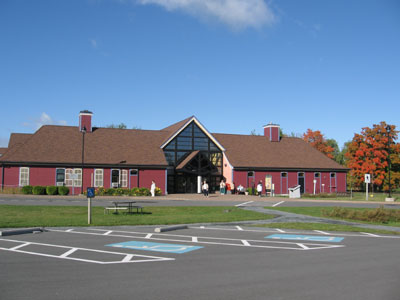To learn more about the Yarmouth area I visited the Yarmouth County Museum whose exhibits highlight the area’s significance in maritime history. I then continued my drive along the Lighthouse Trail, but in an unfortunate incident my rental car landed in a ditch, following which I experienced the instant help of local residents in Chebogue River – and my first-hand experience confirms the well-known stories of Maritime hospitality and generosity.

Several local gentlemen rescued me from the ditch
My driving tour continued to the town of Shelburne, one of the most significant towns in North America in the 1700s. My final destination for Day 3 was Lunenburg – a UNESCO World Heritage Site. I started the next morning with an interesting walking tour of Lunenburg and a brief visit to the Fisheries Museum of the Atlantic.

St. John’s Anglican Church in Lunenburg
I also had a chance to interview Don and Gail Wallace, owners of the Lunenburg Inn, also former Toronto-area residents, who have chosen Lunenburg as their pre-retirement residence. This couple made some strategic plans for their Golden Years and Lunenburg will continue to play a big role in their life.

The famous lighthouse at Peggy’s Cove
Then I headed off on the Lighthouse trail, stopping off in the picturesque communities of Mahone Bay and Peggy’s Cove. On the evening of Day 4 I arrived in Halifax, the capital of Nova Scotia, where I was able to take a moon-lit stroll along the waterfront to my final program point for the day: the musical production DRUM! located at the Drum Theatre at Pier 20.

DRUM! Four Rhythms…Four Cultures…One Heart.
This exhilarating musical production featured the songs and rhythms of Nova Scotia’s four principal cultures: Black, Acadian, Aboriginal and Celtic, and two hours of heart-thumping music, dance and poetry literally gave me goose bumps. The spirit of this performance is captured perfectly by its slogan: FOUR RHYTHMS…. FOUR CULTURES…. ONE HEART.

Statue in the Halifax Public Gardens
My last full day in Nova Scotia began with a tour of Halifax, expertly narrated by a passionate guide – in a kilt. After a visit the Halifax Public Gardens, the Halifax Citadel and the Fairview Garden Cemetery, I was inspired to learn more about Halifax’ history, particularly its connection to the Titanic and the 1917 Halifax Explosion. So I headed into the Maritime Museum of the Atlantic to learn more about the events that shaped this city.

Pier 21 – Canada’s immigration museum
One place that should not be missed on any Halifax itinerary is Pier 21, Canada’s immigration museum. More than 1 million immigrants came through Pier 21, and almost half a million Canadian soldiers were sent from here to join the war effort during the Second World War. During my visit of Pier 21 I had a chance to meet one of the museum’s volunteers: Robert Vandekieft, an 89 year old Canadian immigrant who himself came through the doors of Pier 21 in 1954. He shared his interesting life story with me, a true Canadian success story that illustrates the significance of Pier 21 as Canada’s “front door”.

Robert Vandekieft, Pier 21 volunteer and Canadian immigrant
My time in Nova Scotia was rapidly coming to an end, so in the late afternoon of Day 5 I took the ferry to explore Dartmouth, the “City of Lakes” on the other side of the Halifax Harbour. Today Dartmouth is part of the Halifax Regional Municipality, and an interesting destination in itself. A quiet dinner capped off five intense and action packed days in Nova Scotia.

Sullivan’s Pond, one of the many bodies of water in Dartmouth, “City of Lakes”
I couldn’t help but think of how much I had seen, but I realized that there was so much more to see. I am hoping there will be an opportunity soon to explore more of beautiful Nova Scotia – Canada’s Seacoast.

The Nova Scotia coast – a beautiful spot
